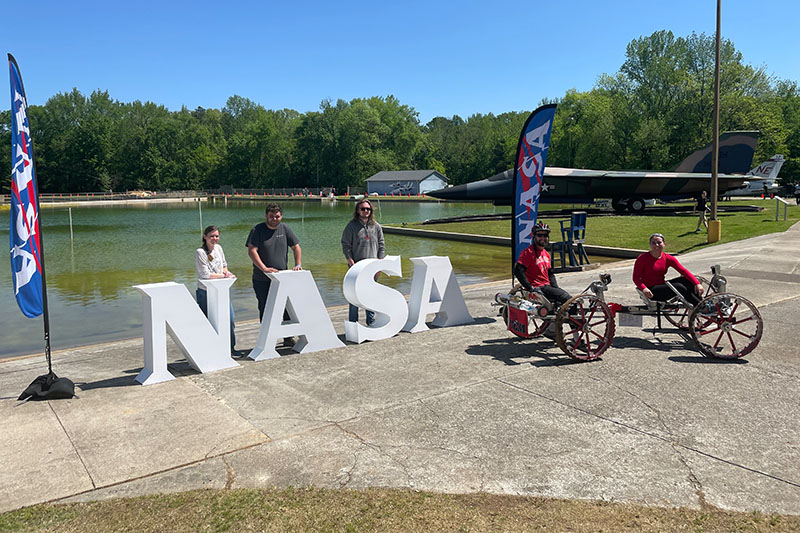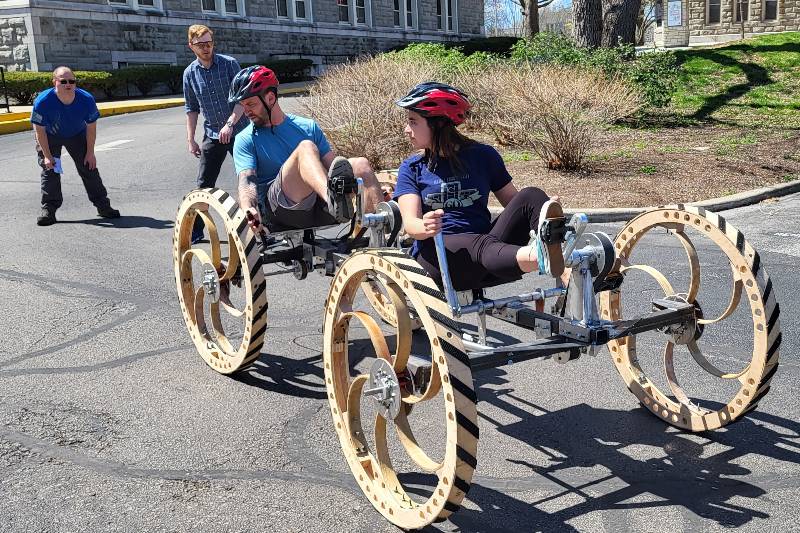Breadcrumb
Engineering Technology Students Finish Sixth at 2023 NASA Human Exploration Rover Challenge in Alabama
By Jeff Murphy, April 27, 2023

University of Central Missouri Engineering Technology - Mechanical Engineering Option
students, from left, Tabitha East, Garyn Carl, Kyle Gann, Seth Martinko, and Allison
Bright, represented the College of Health, Science and Technology at the 2023 NASA
Human Exploration Rover Challenge.
WARRENSBURG, MO – With a tight window for planning, design and fabrication, a team
of Engineering Technology students at the University of Central Missouri are celebrating
a sixth-place finish in the 2023 NASA Human Exploration Rover Challenge. The event,
which included teams from approximately 40 institutions from around the world, took
place Friday and Saturday, April 21-22 at the Marshall Space Flight Center in Huntsville,
Alabama.
UCM Professor of Engineering Technology Troy Ollison and Associate Professor and Engineering
Technology Coordinator Joe Long accompanied the five-member student team on their
journey to Huntsville. They represented the combined efforts of 18 students from the
College of Health, Science and Technology who are enrolled this spring in the Engineering
4221: Manufacturing Problem Solving course.
“I signed up for the class. I honestly didn’t know what we were getting into until
about March,” said Seth Martinko, a senior Mechanical Engineering student from Odessa.
He was excited to learn that he was going to be one of the rover drivers in this competition.
His team was part of an event that included nationally known engineering institutions
such as Purdue and Auburn.
Martinko joined Engineering Technology students, Garyn Carl, senior from Louisburg,
Kansas; and students from Missouri, Kyle Gann, senior from Marshall; Allison Bright,
junior from St. Clair; and Tabitha Easter, a transfer student from Oak Grove, as members
of UCM’s Rover Challenge team. Over a two-day period,
they were tasked with racing their two-person human-powered rover over a three-quarter-mile
course with simulated extraterrestrial terrain in under eight minutes. While UCM has
had previous entries in this annual competition, Ollison said the UCM team began designing
the current rover during the fall 2022 semester and initiated its fabrication this
spring. Doing so required students to follow numerous competition rules that included
documentation as well as developing the rover and its features for optimal performance.
“In order to attain points for the competition, teams must write two detailed planning
and design reports as well as give live presentations to the NASA engineers judging
the event,” Ollison said.
NASA judges assessed these reports and presentations, then the rover was evaluated
and scored on certain criteria. The rovers had overall width and safety requirements
that must be met, but each team could score additional points for meeting other criteria.
This included: being able to fold the rover into a 5x5 foot box; the ability to assemble
(unfold) in less than 30 seconds; creating a rover that weighs less than 210 pounds;
and the rover team’s interaction in local STEM engagement with 250 or more middle
school and/or high school students. Hundreds of high school students attended the
competition.
“The UCM rover did get points for fitting in the 5x5 cube and for assembly taking
less than 30 seconds,” Ollison said. “However, we just missed the weight bonus by
10 pounds and the STEM engagement by 100.”
The Rover Challenge course was set up with many obstacles in which the team had to
overcome, and the competition also included astronaut-based tasks that had to be performed
without leaving the rover. These tasks included retrieving liquid samples from various
mediums and locations, efforts which contributed to the UCM team’s overall score.
“In the end, the UCM rover and drivers performed beautifully,” Ollison said. “Mechanically,
the rover performed above expectations with no failures on either run. The drivers
did an outstanding job navigating the obstacles and tasks while powering the rover
through the course under the allotted eight-minute window.”
In a team meeting the week after the competition, Rover Challenge participants and
Ollison showed video of the competition to those students who were part of the team,
but did not make the trip to Alabama. Team members also responded to questions about
the experience and what they learned.
Gann outlined the process of building the rover from scratch, and the collaboration
that took place from creating a model and fabricating a basic frame and wheels to
installing the drive train and brakes that were designed to meet the competition goals.
He expressed his appreciation for the experience he gained mentoring different groups
of students who were completing various tasks “to make sure the rover came together
in the end and on time.”
The process of putting the rover together entailed many evenings and some weekend
work, according to the team members. This was no small task considering other student
commitments, team members noted..
“Toward the end, we had all the pieces, but we were kind of scrambling to get things
done in the right order,” Easter said.
The team’s persistence paid off. The rover was completed, and the experience in Alabama
opened up new opportunities to continue learning while competing against students
from some of the nation's best engineering institutions.
“It was really cool to see how all the other schools had the same challenges that
we did and then how they came up with different ideas to attack the same challenges,”
Gann said.
The interaction with students from other colleges and universities also provided opportunities
to learn more about other skills, such as different communication styles, which are
essential to team building. UCM students also discovered that the size of their team
– compared to some institutions with 30 to 40 members – was not detrimental to their
success on the rover project, and the UCM team didn’t come to the event less prepared
than other competitors.
“Whenever we got down there,” Bright noted, “our goal was just to finish the course.
We didn’t know how we were going to do, but we just wanted to finish the course in
eight minutes and say that we finished. We ended up doing well that first day, and
thought we can do better tomorrow. It really boosted our confidence. Then when we
were done, we were like, we did good. Now we’re excited for next year.”
The experience only fueled team members’ desire to ensure UCM makes a successful return
trip to the NASA Human Exploration Rover Challenge in 2024. Team members spent part
of their long drive back to Warrensburg discussing what could possibly be changed
with the rover to improve next year’s chances for higher placement. Whatever happens
in the future, faculty members who were part of this effort were impressed by the
students' commitment to a successful outing in Alabama.
“This competition was very challenging but rewarding. Some of the most challenging
aspects have been students working effectively as a team and understanding there is
more than one way to do something,” Ollison said. “Time was another huge challenge.
Only having a few months to fabricate and test the rover was maybe the students’ biggest
hurdle. And to make matters worse, the suspension wheels designed for this race failed
during testing six days before the competition and old wheels had to be retrofitted
in order to race.”
Regardless of such obstacles, the student team proved they could rise above the challenges.
“As a faculty adviser for this project, I can’t explain how proud I am of all the
students who were part of this,” Ollison said. “I also want to thank all of the faculty
and industry professional that helped with fabrication and donated materials.”
To learn more about the NASA Human Exploration Rover Challenge visit the event website. More information about UCM’s Bachelor of Science in Engineering Technology – Mechanical Engineering Option is available online or by calling Ollison at 660-8660 or emailing ollison@ucmo.edu.

Driven by Seth Martinko, rear, and Allison Bright, front, a pedal-powered rover developed
by students in the Engineering 4221: Manufacturing Problem Solving course, gets a
test drive outside the UCM Administration Building days before heading to the 2023 NASA Human Exploration Rover Challenge.








